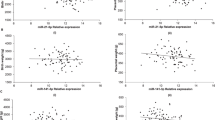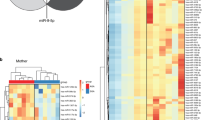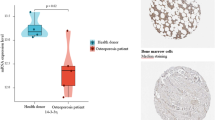Abstract
Background
The current study mainly focused on provide further insights into the association of the miR-22-3p and miR-29c-3p expression in CFU-Hill colonies with birth weight and senescence process in children.
Methods
This cross-sectional study evaluated 61 children (32 boys, 29 girls). The CFU-Hill colonies number was evaluated in vitro by cell culture technique and senescence was detected by β-galactosidase (SA-β-Gal) assay. Expression of miR-22-3p and miR-29c-3p isolated from CFU-Hill colonies were detected using quantitative real-time polymerase chain reaction.
Results
Birth weight was correlated with both CFU-Hill colonies and %SA-β-Gal positive staining. Multivariate linear regression analysis revealed that the senescence was a predictor of the lower CFU-Hill colonies number, while only the birth weight was a predictor of senescence of CFU-Hill colonies. Overexpression of miR-22-3p and miR-29c-3p was observed in CFU-Hill colonies isolated from children with low birth weight (LBW). Interestingly, we found a significant correlation between %SA-β-Gal cells staining positive for both miR-22-3p and miR-29c-3p.
Conclusion
The LBW is associated with decreased CFU-Hill colonies number and high senescence of these cells. The overexpression of miR-22-3p and miR-29c-3p may be partially responsible for this alteration due to regulation of several pathways related to the senescence process.
Impact
-
The study establishes a significant correlation between birth weight and the number of CFU-Hill colonies, suggesting that birth weight could be a predictive biomarker for vascular health in children.
-
Data indicates that cellular senescence is a predictor of reduced CFU-Hill colony numbers. This suggests that the aging process of these cells could be an important factor in understanding the vascular health issues in children with low birth weight.
-
The overexpression of miR-22-3p and miR-29c-3p in children with low birth weight and their correlation with increased cellular senescence highlight these microRNAs as possible molecular mechanisms influencing the aging of CFU-Hill colonies.
This is a preview of subscription content, access via your institution
Access options
Subscribe to this journal
Receive 14 print issues and online access
$259.00 per year
only $18.50 per issue
Buy this article
- Purchase on Springer Link
- Instant access to full article PDF
Prices may be subject to local taxes which are calculated during checkout




Similar content being viewed by others

Data availability
The data underlying this study will be shared on reasonable request to the corresponding author.
References
Liang, J. et al. Association between birth weight and risk of cardiovascular disease: Evidence from UK Biobank. NMCD 31, 2637–2643 (2021).
Franco, M. C., Christofalo, D. M., Sawaya, A. L., Ajzen, S. A. & Sesso, R. Effects of low birth weight in 8- to 13-year-old children: implications in endothelial function and uric acid levels. Hypertension 48, 45–50 (2006).
Norman, M. Low birth weight and the developing vascular tree: a systematic review. Acta Paediatrica 97, 1165–1172 (2008).
Urbich, C. & Dimmeler, S. Endothelial progenitor cells: characterization and role in vascular biology. Circ. Res. 95, 343–353 (2004).
Balaji, S., King, A., Crombleholme, T. M. & Keswani, S. G. The Role of Endothelial Progenitor Cells in Postnatal Vasculogenesis: Implications for Therapeutic Neovascularization and Wound Healing. Adv. Wound Care 2, 283–295 (2013).
Hill, J. M. et al. Circulating endothelial progenitor cells, vascular function, and cardiovascular risk. N. Engl. J. Med. 348, 593–600 (2003).
Medina, R. J. et al. Endothelial Progenitors: A Consensus Statement on Nomenclature. Stem cells Transl. Med. 6, 1316–1320 (2017).
Ligi, I. et al. A switch toward angiostatic gene expression impairs the angiogenic properties of endothelial progenitor cells in low birth weight preterm infants. Blood 118, 1699–1709 (2011).
Ligi, I. et al. Altered angiogenesis in low birth weight individuals: a role for anti-angiogenic circulating factors. J. Matern. Fetal Neon. Med. 27, 233–238 (2014).
Souza, L. V. et al. Detrimental Impact of Low Birth Weight on Circulating Number and Functional Capacity of Endothelial Progenitor Cells in Healthy Children: Role of Angiogenic Factors. J. Pediatr. 206, 72–77 (2019).
Salazar-Martinez, E., Rodriguez-Valentin, R., Albavera-Hernandez, C., Carreon-Rodriguez, A. & Lazcano-Ponce, E. Number of colony-forming unit-Hill colonies among children and teenagers with obesity, dyslipidemia and breastfeeding history. NMCD 26, 534–540 (2016).
Vassallo, P. F. et al. Accelerated senescence of cord blood endothelial progenitor cells in premature neonates is driven by SIRT1 decreased expression. Blood 123, 2116–2126 (2014).
Simoncini, S. et al. Biogenesis of Pro-senescent Microparticles by Endothelial Colony Forming Cells from Premature Neonates is driven by SIRT1-Dependent Epigenetic Regulation of MKK6. Sci. Rep. 7, 8277 (2017).
Nikolajevic, J. et al. The Role of MicroRNAs in Endothelial Cell Senescence. Cells 11, 1185 (2022).
Krol, J., Loedige, I. & Filipowicz, W. The Widespread Regulation of microRNA Biogenesis, Function and Decay. Nat. Rev. Genet. 11, 597–610 (2010).
Liang, H. et al. miR-22-3p Suppresses Endothelial Progenitor Cell Proliferation and Migration via Inhibiting Onecut 1 (OC1)/Vascular Endothelial Growth Factor A (VEGFA) Signaling Pathway and Its Clinical Significance in Venous Thrombosis. Med. Sci. Monit. 26, e925482 (2020).
Zhou, C. et al. Preeclampsia Downregulates MicroRNAs in Fetal Endothelial Cells: Roles of miR-29a/c-3p in Endothelial Function. J. Clin. Endocrinol. Metab. 102, 3470–3479 (2017).
de Onis, M. et al. Development of a WHO growth reference for school-aged children and adolescents. Bull. W. Health Organ. 85, 660–667 (2007).
National High Blood Pressure Education Program Working Group on High Blood Pressure in Children and Adolescents. The fourth report on the diagnosis, evaluation, and treatment of high blood pressure in children and adolescents. Pediatrics 114, 1–22 (2004).
Kumari, R. & Jat, P. Mechanisms of Cellular Senescence: Cell Cycle Arrest and Senescence Associated Secretory Phenotype. Front. Cell. Dev. Biol. 9, 645593 (2021).
Lu, Q. & Rounds, S. Focal adhesion kinase and endothelial cell apoptosis. Microvasc. Res. 83, 56–63 (2012).
Bent, E. H., Gilbert, L. A. & Hemann, M. T. A senescence secretory switch mediated by PI3K/AKT/mTOR activation controls chemoprotective endothelial secretory responses. Gen. Dev. 30, 1811–1821 (2016).
Del Re, D. P., Miyamoto, S. & Brown, J. H. Focal adhesion kinase as a RhoA-activable signaling scaffold mediating Akt activation and cardiomyocyte protection. J. Biol. Chem. 283, 35622–35629 (2008).
Liu, D. & Xu, Y. p53, oxidative stress, and aging. Antioxid. Red. Sign. 15, 1669–1678 (2011).
Funding
This study was funded by a project grant from the Fundação de Amparo à Pesquisa do Estado de São Paulo (FAPESP) (N°. 2015/20082-7) (N°. 2018/04013-3). Franco MC receives a research grant from the Conselho Nacional de Desenvolvimento Científico e Tecnológico (CNPq) (N° 302879/2019-6) and CAPES-PRINT (N°. 88881.310737/2018-01).
Author information
Authors and Affiliations
Contributions
P.R.P.S., F.T., L.V.S. and C.L.F. contributed to the investigation, acquisition, analysis, or interpretation of data for the work, and drafted the manuscript. M.C.F. contributed to the conceptualization, data curation, supervision, funding acquisition, project administration, and writing—review & editing. All authors critically revised the manuscript, gave final approval, and agreed to be accountable for all aspects of work ensuring integrity and accuracy.
Corresponding author
Ethics declarations
Competing interests
The authors declare no competing interests.
Ethics approval and consent to participate
This study was approved by the Research Ethics Committee of the Federal University of São Paulo (approval number: 3.318.000). Written informed consent was obtained from all parents or guardians, while written assent was obtained from all children.
Additional information
Publisher’s note Springer Nature remains neutral with regard to jurisdictional claims in published maps and institutional affiliations.
Rights and permissions
Springer Nature or its licensor (e.g. a society or other partner) holds exclusive rights to this article under a publishing agreement with the author(s) or other rightsholder(s); author self-archiving of the accepted manuscript version of this article is solely governed by the terms of such publishing agreement and applicable law.
About this article
Cite this article
Souza, P.R.P., Thomazini, F., Souza, L.V. et al. Overexpression of miR-22-3p and miR-29c-3p in CFU-Hill colonies is related to senescence process among children with low birth weight. Pediatr Res (2024). https://doi.org/10.1038/s41390-024-03128-0
Received:
Revised:
Accepted:
Published:
DOI: https://doi.org/10.1038/s41390-024-03128-0


